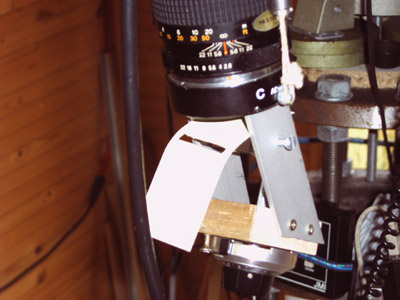|
|
||||||||
|
|
||||||||
|
Welcome to Norbert Reinecke’s ‘K E Y H O L E’ - O B S E R V A T O R Y |
|
Spectral Resolution vs. Grating Dimension Question: What is the necessary dimension of a grating to reach the best system’s spectral resolution possible? Theoretical resolution of a grating: R = m x n x a where m is the order of diffraction, n is the density of grooves (lines/mm) and a ist the grating’s dimension (mm). For n=1200 l/mm it is clear that a 30mm grating comes with R = 36000 which is far better compared to the system’s overall resolution (R = 4000). Hence one does not need an expensive large grating. 30 x 30 mm is more than enough as far as resolution is concerned. In order to proof this dependancy I took Ne spectra covering various portions of the grating’s surface with a paper mask comprizing 2, 4 and 8mm openings: |
||||||||
 |
||||||||
|
The resulting Ne linewidth vs. uncovered number of grooves is as follows: 1 mm opening (1200 grooves) results in 6 Pix FWHM 4 mm opening (4800 grooves) results in 5 Pix FWHM 8 mm opening (9600 grooves) results in 2 Pix FWHM Full surface 30 x 30 mm results in aprox. 2-3 Pix FWHM. |
||||||||
|
Conclusio: Just as theoretical considerations require, the overall system’s resolution (best: R=4000) does depend on the number of the grating’s grooves as long as it is the dominating factor. In case of my spectrograph starting from 8mm grating dimension and above the overall resolution is totally independant of the grating’s dimension. If it is possible to build a spectrograph with appropriate F# along the optical train one could save money by purchasing small size gratings. |
|
[Home] [Observatory] [Gallery] [Spectroscopy] [Private] |